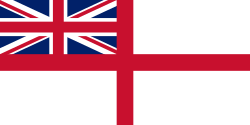skip to main |
skip to sidebar
Royal Navy of the United Kingdom
8:12 AM
Posted by Peace Keeper

The Royal Navy of the United Kingdom, founded in the 16th century, is the oldest of HM Armed Forces (and is therefore known as the Senior Service). From the 17th century until well into the 20th century it was the most powerful navy in the world, playing a key part in establishing the British Empire as the dominant world power from 1815 until the second third of the 20th century. In World War II the Royal Navy operated almost 900 ships. During the Cold War it was transformed into a primarily anti-submarine force, hunting for Soviet submarines, mostly active in the GIUK gap. With the collapse of the Soviet Union, its role for the 21st century has returned to focus on global expeditionary operations.
The Royal Navy is a blue-water navy and the second-largest navy of the NATO alliance, in terms of the combined displacement (approx. 450,000 long tons (460,000 t) (950,000 long tons (970,000 t) including the Royal Fleet Auxiliary) after the United States Navy. February 2011 there were 81 commissioned ships in the Royal Navy, including helicopter carriers, landing platform docks, ballistic missile submarines, nuclear fleet submarines, guided missile destroyers, frigates, mine counter-measures and patrol vessels. 16 vessels of the Royal Fleet Auxiliary (RFA) also contribute to the Royal Navy's order-of-battle. The Royal Navy's ability to project power globally is considered second only to the U.S. Navy. The Royal Navy maintains the United Kingdom's nuclear weapons.
The Royal Navy is a constituent component of the Naval Service, which also comprises the Royal Marines, Royal Naval Reserve and Royal Marines Reserve. As of February 2011 the Royal Navy numbered approximately 38,190 Regulars and 3,600 Navy Volunteers. In addition, there were 19,560 Regular Reserves.
The Royal Navy is also supported by the Royal Fleet Auxiliary, a civilian logistical support fleet which is owned and operated by the Ministry of Defence as part of the British Merchant Navy. The RFA primarily serves to replenish Royal Navy warships at sea, but also augments the Royal Navy's amphibious warfare capabilities through its three Bay-class LSDs (Landing Ship Dock).
| Royal Navy | |
|---|---|
 Naval Ensign | |
| Active | 16th century - present |
| Country | |
| Allegiance | Queen Elizabeth II |
| Type | Navy |
| Size | Available manpower;
Reserve manpower;
103 ships including RFA |
| Part of | British Armed Forces |
| Naval Staff Offices | Ministry of Defence Main Building, Whitehall |
| Motto | Latin: Si vis pacem, para bellum If you wish for peace, prepare for war |
| Colours | Red and White |
| March | "Heart of Oak" |
| Commanders | |
| First Sea Lord | Admiral Sir Mark Stanhope |
| Aircraft flown | |
| Attack | Lynx |
| Patrol | Merlin, Lynx, Sea King ASaC.7 |
| Trainer | Tutor, Hawk, Jetstream, Firefly |
| Transport | Sea King |
Related Post
This entry was posted on October 4, 2009 at 12:14 pm, and is filed under
Royal Navy
. Follow any responses to this post through RSS. You can leave a response, or trackback from your own site.